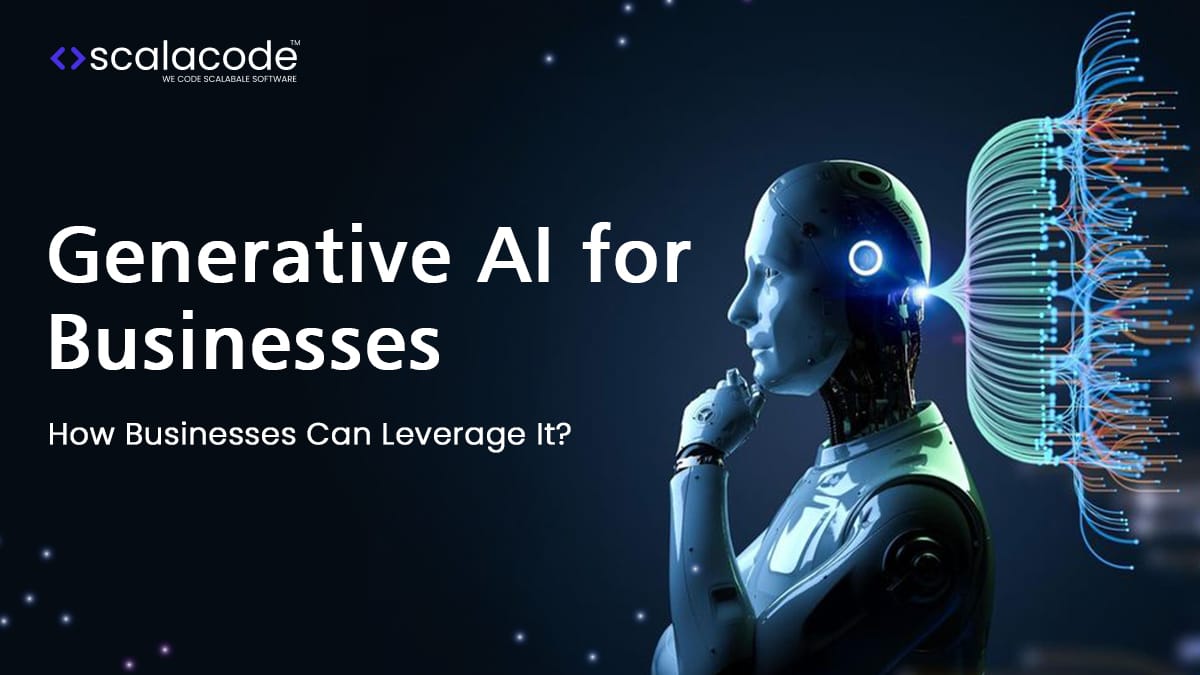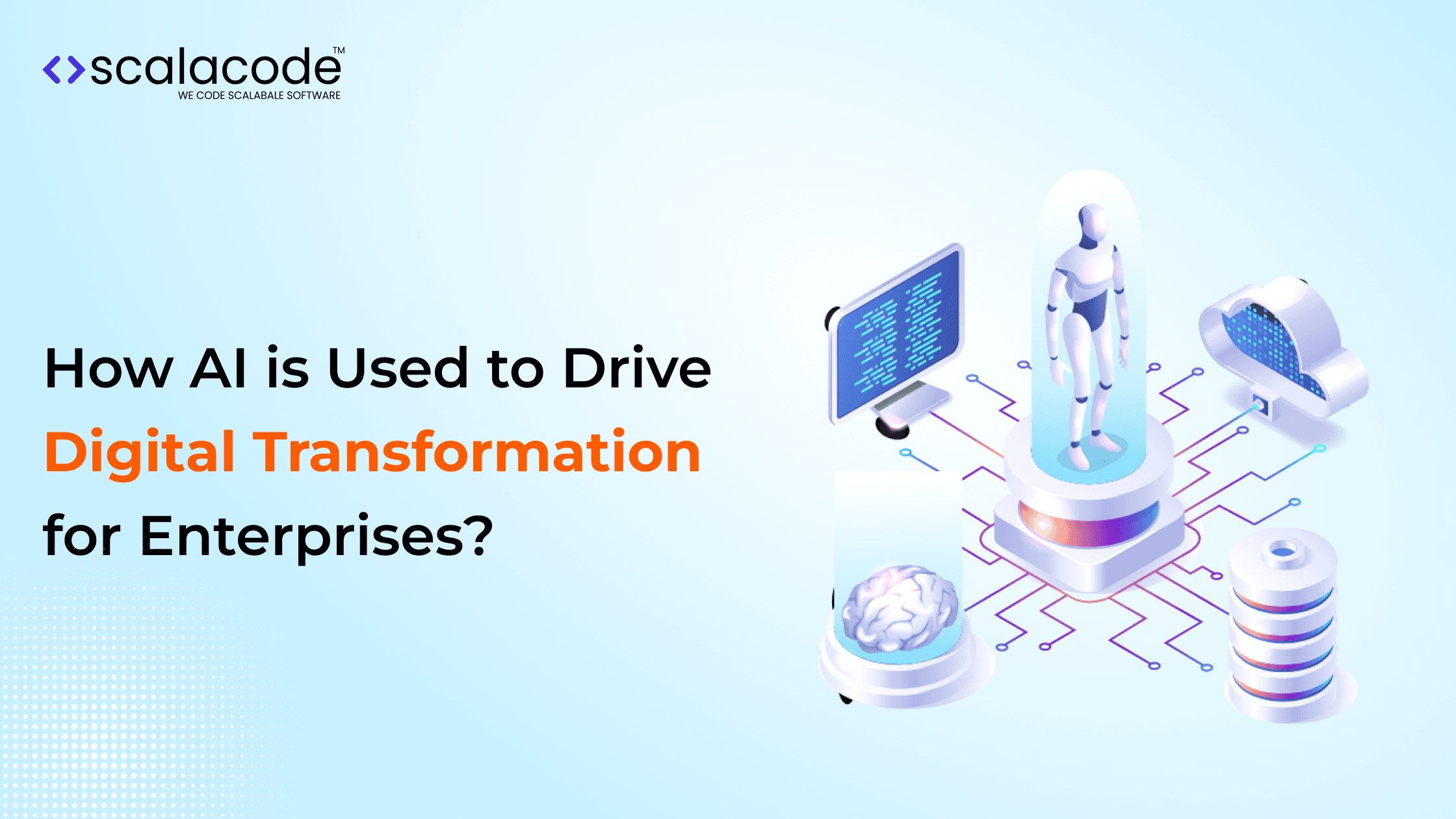Business leaders are increasingly intrigued by innovations such as ChatGPT. They are eager to determine whether these generative AI developments are mere buzz or have the potential to significantly disrupt their companies.
And if integrating this technology is deemed beneficial for businesses, how should they go about leveraging generative AI technology effectively?
Well, if we look at the uses of the ChatGPT model and other generative AI tools, we quickly realize that these technologies are not just fleeting trends.
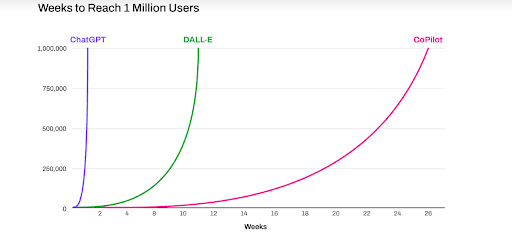
| Product | Time to reach 1 million users | Source |
| ChatGPT | 5 days | Greg Brockman, Co-Founder of OpenAI |
| DALL-E | 2.5 months | Sam Altman, Co-Founder of OpenAI |
| GitHub Copilot | 1 month (400,000 subscribers) | Microsoft |
Instead, they offer a plethora of practical applications that open new revenue streams for businesses. Below, we explore several key ways in which businesses can leverage generative AI technology to their advantage.
But before that, let’s have more info about the generative AI market value. This will give you a better idea of the scale at which generative AI is impacting industries globally.
The Generative AI Market Value That Businesses Should Know
According to recent market research done by reputed institutions, the global generative AI market is expected to grow exponentially in the coming years.
As per Fortune Business Insights, the worldwide market for generative AI was worth about $43.87 billion in 2023. In 2024, it is expected to reach roughly USD 67.18 billion. And by 2032, the value may reach USD 967.65 billion.
This indicates a whopping annual growth rate of around 39.6% during this period (2024–2022).
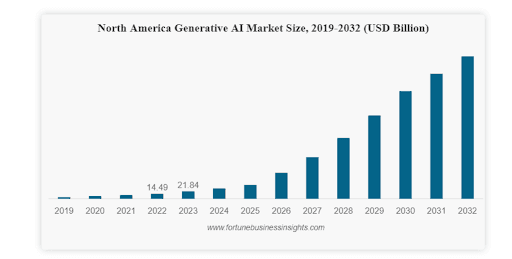
Also, in a series of webinars and polls by Gartner, the latest poll shows that 21% of organizations now have generative AI (GenAI) solutions up and running.
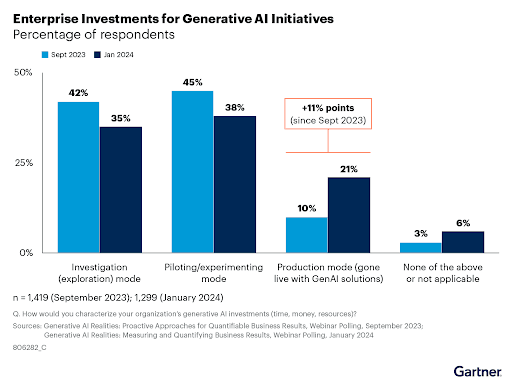
Furthermore, the survey discovered that 45% of companies are expanding their investments in generative AI to cover various business areas.
Among these, 22% are extending these investments across more than three different functions. When it comes to which areas are embracing generative AI the most, custom software development services takes the lead. The second item on the list is marketing and customer service.
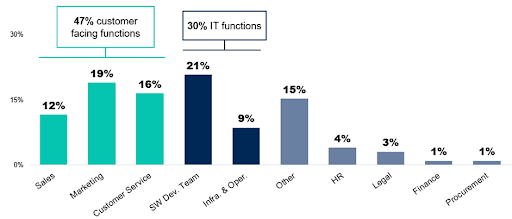
Moving ahead, this shot of statistics gives a sense of the widespread adoption and investment in generative AI technologies across various sectors. This forecast not only demonstrates the financial potential of generative AI but also highlights its capacity to revolutionize traditional business models.
With this promising outlook, businesses are looking for ways to incorporate generative AI into their operations.
So, with this blog, we will aim to demystify the application of generative AI for businesses and outline practical steps for integrating this cutting-edge technology into your operations.
Moreover, to gain an edge in business, leaders should grasp what generative AI means.
What is generative AI?
Generative AI involves algorithms that utilize data to generate content—be it text, images, or even code—that is new and original. Unlike traditional AI models that are designed to predict outcomes or classify data, generative AI focuses on the creation aspect.
The most advanced generative AI algorithms are built on foundational models trained on large amounts of unlabeled data. This training helps them recognize patterns for various tasks.
Popular examples include text generators like ChatGPT and image creation tools like Midjourney.
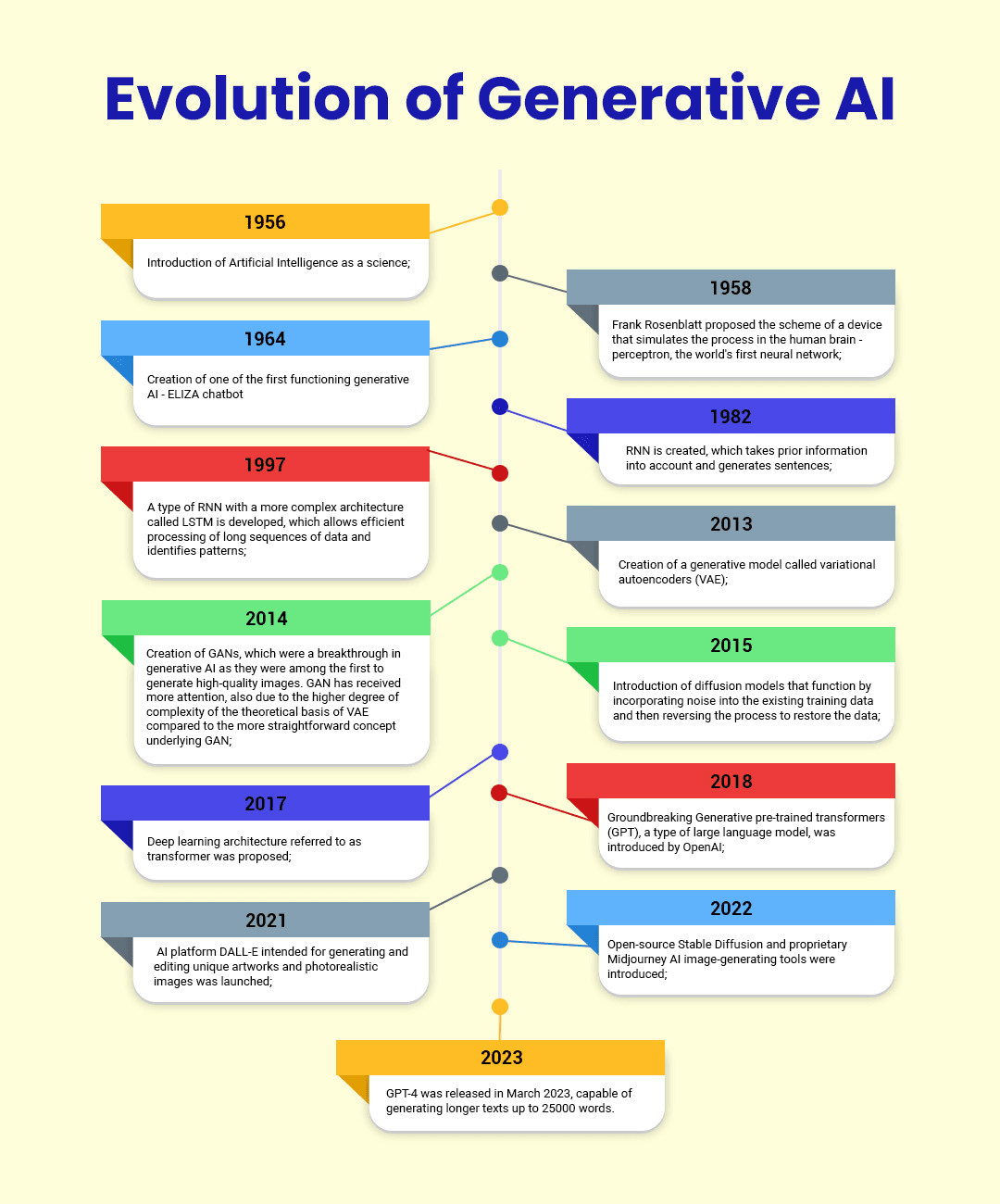
Now, before investing in generative AI development services, businesses should consider a few things. What? Let’s find them below:
How can businesses implement generative AI?
For implementing generative AI, businesses have two main options:
- Using Commercially Available Software
We have platforms like OpenAI. These offer easy-to-use interfaces and tools for integration. With this available software, you can build your own Generative AI product, even for those with limited AI experience. You can also enhance these solutions by fine-tuning them with your own data, improving accuracy.
- AI Foundational Models
You can opt for models such as GPT-3 or DALL-E and either use them straight out of the box or train them with your data. This gives you more flexibility and authority. However, implementing this option, there is a demand for a higher level of technical expertise in AI development services, its tools, resources, and time on your part.
Besides these two, there is a third option:
- Build Your Own Model
Building a generative AI model from scratch is possible but not recommended unless you have substantial resources and expertise. For better results, partner with a reputed AI development company. They have a team of AI developers and OpenAI developers, which means you gain access to professionals who are well-versed in the latest AI technologies, methodologies, and best practices.
Furthermore, below, we have shared a list of the generative AI models that are popular among businesses.
Types of Generative AI Models Businesses Commonly Use
| Category | Model | Description |
| Text | GPT-3, LaMDA, LLaMA | Autoregressive models for high-quality text generation |
| Text | GPT-4 | Large-scale multimodal model for text generation with image/text inputs |
| Multimodal | DALL-E | Creates images from text descriptions |
| Multimodal | Stable Diffusion | Text-to-image model using diffusion for image creation |
| Multimodal | Progen | Generates proteins based on text descriptions |
Now, let’s know – the applications of Generative AI in business.
How Can Businesses Leverage Generative AI?
“Organizations are not just talking about generative AI; they’re investing time, money, and resources to move it forward and drive business outcomes,” said Frances Karamouzis, Chief of Research at Gartner.
With this statement in mind, let’s explore how businesses can effectively leverage generative AI to streamline operations, enhance customer experiences, and drive innovation.
1. Content Creation
Content creation is one of the simplest ways Gen AI will be used for businesses, which is just one example. A marketing team, for example, could leverage AI to produce content that is in line with the company brand but more creative than what could be achieved by copy-paste.
This way, the team saves considerably on money and time otherwise needed for the process. Forget about the time-consuming task of writing original product descriptions, blog posts, or social media content. GenAI makes it as simple as a prompt.
Besides, generative AI can be used for creating visuals for marketing campaigns or product prototypes, which is an hour-saving manual labor consuming one’s time and, at the same time, serves as an innovation-boosting factor.
2. Enhancing customer experiences
Generative AI is also a key innovator in personalized customer relations. AI technology can enable e-commerce sites to make suggestions that are based on much more than customers’ personal histories, but by being able to immerse themselves in the depth of customer preferences and the meaning behind them
In sectors where client interactions are critical, linguistic AI models such as ChatGPT can optimize operations by delivering tailored, informed responses in text chats or as a call agent guide. This can enhance communication protocols and improve customer satisfaction.
3. Streamlining Operations and Innovations
Generative AI can inspire innovation by providing businesses with the ability to quickly prototype new ideas. Whether it’s experimenting with new product designs or exploring untapped markets with tailored content strategies, the technology opens up a world of possibilities.
Small businesses can use generative AI solutions, like ChatGPT, to improve operational reliability by reducing waste and boosting efficiency. This AI can help organize scattered data and provide actionable insights in natural language, enabling businesses to make informed decisions quickly.
For example, it can assist in investigating risks and speeding up decision-making processes, leading to smoother operations overall.
4. Automating Test Writing for Code
Generative AI can be a valuable asset for small software businesses by automating the writing of tests for code, which is often a time-consuming task. For instance, GitHub’s Copilot can automatically generate tests, acting as an “autocomplete” for coding. This automation can save significant time and effort, effectively increasing the productivity of the engineering team.
5. Creating Chatbots
Chatbots are automated chat systems on websites that can provide 24/7 service, generate new leads, and answer frequently asked questions. Generative AI can enhance these chatbots by enabling them to learn from previous conversations and adapt to different contexts, resulting in more personalized and human-like responses. This can significantly improve customer satisfaction, loyalty, and retention.
6. Building Customized Marketing Plans
Generative AI can be a valuable asset for businesses looking to develop marketing and sales plans. By asking AI to build an outline, businesses can then customize it for their specific market and competition. This framework can help businesses stay focused on the details of their marketing strategy rather than getting bogged down in the formatting.
7. Applying Sentiment Analysis to Online Feedback
AI can be used to apply sentiment analysis to online feedback, helping businesses identify high-impact goods and services as well as areas for improvement. This data can then be used to create insights and strategies to achieve larger business goals.
Benefits of Generative AI for Businesses
According to BCG, 94% of leaders recognize AI’s critical role in the next five years. Let’s explore how generative AI can benefit businesses in a simple and engaging way.
1. Automated Content Production
Generative AI helps businesses create content efficiently. It can produce articles, marketing materials, and even code, saving time and resources. For example, marketers and sales specialists commonly use it for basic text creation. Over 50% of business leaders have adopted this technology for content marketing, ensuring a consistent brand voice. This is a reason why AI in digital transformation plays such a critical role.
2. Personalization
Generative AI enables highly personalized customer experiences, leading to higher sales and client satisfaction. It powers recommendation engines and voice assistants, enhancing user engagement. Statistics show that 73% of consumers anticipate enhanced personalization, leading to increased sales.
3. Routine task automation
Generative AI automates routine tasks, freeing employees for higher-value activities. Modern AI can automate tasks that take up to 60 to 70% of employees’ time, creating a more dynamic workplace.
4. Data Analysis and Insights
Generative AI excels in data analysis, identifying trends and anomalies. This data enables data-driven decision-making and a deeper understanding of operations and customer behavior.
5. Cost reduction and time savings
Generative AI reduces operational costs and saves time by automating repetitive tasks. This allows companies to reallocate resources to more critical areas, increasing efficiency. Employees using generative AI save an average of 1.75 hours daily, a full workday each week. In financial services, 36% reported reducing annual costs by over 10%.
Examples of companies using generative AI for their businesses
1. OpenAI
OpenAI revolutionized generative AI with the release of ChatGPT in 2022. Since then, its innovations have reshaped content generation and AI research. Backed by major tech players like Microsoft, OpenAI is now valued at over $80 billion, making it a dominant force in the industry.
Apart from ChatGPT and DALL-E, OpenAI offers a suite of generative AI models. These include Codex, which powers GitHub Copilot and helps software engineers by suggesting code completions and generating programming code from natural language descriptions.
Plus, they have models like:
| Category | Specific Capability | Example |
| Text | Chat models | ChatGPT |
| Text | Instruct models | Fine-tuning GPT-3 to follow instructions for specific tasks (e.g., writing different kinds of creative content) |
| Text | Fine-tuning models | GPT-3 (allows customization for specific tasks) |
| Audio | Audio models | Whisper (speech recognition model) |
| Image | Image models | DALL-E 2 (generates images from text descriptions) |
Either business can engage engineers and OpenAI developers who will customize these AI technical designs for their unique purposes, indicating the beginning of a new era in artificial intelligence.
OpenAI offers Sora, a video solution based on generative AI, in addition to GPT Store, a simplified option for the selection of different GPT agents dedicated to your business needs. These innovations are the hallmark of OpenAI’s corporate ambition to become the leader of generative AI and make it more available to businesses.
2. Adobe
For years, Adobe has been the creative software standard, but now it is taking a bold step forward into the world of AI for the creative user experience. The provision of individual offerings that are natively integrated with both the Creative Cloud and the Experience Cloud. Users are now able to utilize power-generative AI capabilities for the full range of their personal and business projects.
Adobe’s generative AI initiatives are Sensei and Firefly, two remarkable services that are aimed specifically at boosting creativity and making people’s work more efficient. There are other projects Adode launched in the Gen AI field; the list is as follows-
Adobe Generative AI Products
| Product Name | Feature | Availability |
| Firefly | Collection of generative AI tools | Beta testing |
| Generative Fill (Photoshop) | Uses AI to fill in missing areas of images | Beta testing within Photoshop |
| Alpaca (Photoshop plugin) | Generates art based on text prompts | Beta testing within Photoshop |
| Augur Labs | Creates videos from text descriptions | Beta testing |
Adobe’s generative AI platforms are designed to make your marketing content creation more efficient as well as enable you to develop state-of-the-art customer experiences.
3. Google
Artificial intelligence has been a major field of interest at Google since 2017. The scalability together with ethics are considered as the key areas to master. The dedication is manifest in the company’s latest product, Gemini, which has generated a lot of attention around its features for AI generation.
Gemini Privacy: It was the first browser that allowed users to browse the internet anonymously, shielding their online identity and location from digital advertisers, hackers, and governments.
Whichever of Gemini’s AI chatbot versions users take, they have the power to input such images and blend their outputs that come with external web links. Additionally, Gemini has produced quality management as well as fact-checking features to ensure the reliability of the outputs.
Some of the products are-
- Google AI Studio
- Gemini
- Project IDX
Challenges Businesses Face While Leveraging Generative AI
While generative AI technology can enhance many aspects of business, it’s important to use it carefully. With the right guidance, generative AI can bring novel solutions and improve existing processes. Businesses are now exploring how to integrate this technology into their operations. Some are eager to dive in, while others prefer a more cautious approach. Whatever,
Challenge 1: Technical Complexity
Generative AI models can be huge, with billions or even trillions of parameters. This makes training them a big task that requires a lot of computing power. Most businesses will use them through cloud services because training them is too expensive and not eco-friendly. This can lead to power being concentrated in a few big companies.
Challenge 2: Technical Debt
If businesses don’t make big changes with AI, they might end up with more problems. For example, if generative AI is used in customer support, the number of human agents should go down significantly to justify the investment. Businesses need to ensure that AI implementations result in tangible benefits to avoid accumulating technical debt.
Challenge 3: Legacy Systems
Older systems may not work well with generative AI. Companies might need to decide whether to update these systems or replace them. This decision involves weighing the benefits of generative AI against the costs and complexities of integrating it into legacy systems.
Challenge 4: Misuse and Misinformation
Generative AI models can be misused to create deep fakes and misinformation. Additionally, AI models can sometimes generate inaccurate or false information, known as AI hallucinations. Businesses need to be vigilant in monitoring AI systems for misuse and ensuring that the information they generate is accurate and reliable.
Challenge 5: Legal Issues
Using generative AI models without the right permissions can lead to legal trouble. Also, if these models are trained on biased data, they can make biased decisions, which is unfair. Therefore, as a business leader, you need to address these legal and ethical considerations when deploying these types of AI solutions.
Challenge 6: Coordination and Oversight
Businesses might need a special team—an AI development company—to understand and use generative AI properly. This team can also make sure that AI is used correctly and ethically.
Challenge 7: Changing Jobs
Generative AI is likely to change how work is done in many industries, raising concerns about job losses. While AI may reduce the need for certain types of jobs, it also creates new roles. For example, AI-powered customer support systems may reduce the number of frontline support agents needed but create new roles for overseeing and improving the AI system.
The Future of Generative AI in Business
The examples mentioned above showcase just a fraction of what is possible with generative AI. The potential applications of this technology in business are vast and varied. From personalizing customer experiences and automating content creation to optimizing operations and aiding in decision-making, the ways in which businesses can leverage generative AI are limitless.
Moreover, as the technology continues to evolve, we are likely to see even more innovative uses emerge. For instance, generative AI could play a significant role in sustainability efforts by optimizing energy usage in manufacturing or providing solutions for reducing waste. The potential for enhancing product design and customer service through deeper insights and creativity is also immense.
However, it’s important for businesses to approach the adoption of generative AI thoughtfully. Ethical considerations, such as the potential for misuse of the technology and concerns about data privacy, need to be addressed. Businesses should also be prepared for the challenges of integrating generative AI into their existing systems and processes, including ensuring they have the right skills and infrastructure in place.
How Do You Integrate Generative AI into Your Business?
To effectively integrate generative AI into your business operations, follow these steps:
1. Identify the need
Whether it’s content generation, customer service, or product development, understanding your needs will guide the selection of appropriate generative AI tools.
You might have many ideas for using generative AI in your business. But because of limits like knowing how, money, and time, you need to choose if you’ll make your own or use someone else’s. To decide, think about areas that make a strong plan for your company. Here are some questions to help you:
- What specific problems or challenges are you looking to solve with generative AI?
- Which tasks consume a significant amount of your or your team’s time and could be automated?
- Are there areas of your customer experience that could be enhanced with more personalized or dynamic content?
- Do you have unique needs that off-the-shelf generative AI solutions cannot meet, thus requiring custom development?
2. Choose the Right Tools
Not all generative AI solutions are created equal. Evaluate options based on their ease of use, compatibility with your existing tech stack, and the specific capabilities you require. Some of the best generative AI tools and platforms that you can use for development are listed below:
- ChatGPT
- Scribe
- AlphaCode
- GitHub Copilot
- GPT-4
- Gemini
- Cohere Generate
- Dall-E2
- Claude
- Synthesia
- Duet AI
3. Pilot Small Projects
Becoming good at AI takes time, especially for specific uses. Start with tasks inside your company that cost a lot. For example, if your business needs data entry or form verification, AI can help. It can start by making people doing these jobs more productive before doing the jobs themselves. People can check if the AI’s answers are right.
Start with a small team working on these AI features. You don’t need experts in AI, but you’ll need two types of skills at least:
- Someone who knows what the AI needs to do and checks if it’s right
- A software engineer who can connect the AI to your systems
Most of the work can be done by the person who knows what the AI needs to do. They will spend most of their time making sure the AI understands what you need.
Once this team learns about the first use, they can help with other uses and figure out how to use generative AI in your business.
4: Test a Lot
Some people worry that generative AI might not always give the right answers. When building any AI application (starting with the first one), test it a lot before and after it’s live.
For testing, make a list of what the AI should do and what the answers should look like. Test the AI with these and see if it’s close enough. Change the way you ask or the AI’s settings until it’s better.
Once the AI is live, track how users react. Some will be clear (like clicking ‘Send’ on an AI-made email without changing anything), and some will need a thumbs-up or down. Tracking where the AI doesn’t do well will help you make it better next time.
5. Invest in training
Ensure your team is equipped to work with generative AI by investing in training. Familiarity with the technology will enable them to leverage it effectively and innovate within their roles.
6. Stay Informed
The field of AI is rapidly evolving. Stay informed about the latest developments in generative AI to continually refine and expand its application within your business.
Final thoughts
Generative AI isn’t just a cool thing; it’s changing how businesses work. Using generative AI can help you be more creative, efficient, and innovative. Businesses that understand this early on can get ahead.
Generative AI is changing how we use technology and get information. As it becomes a big part of business strategies, it’s clear that it’s here to stay.
Even though people are excited about technologies like ChatGPT, it’s important to know that this isn’t just a trend. It’s the coming together of different technologies like AI and NLP, making something powerful. This change will make unstructured data easier to use for both businesses and consumers.
Therefore, stick to us at ScalaCode, a leading AI development company, to get innovative, next-generation AI products.
